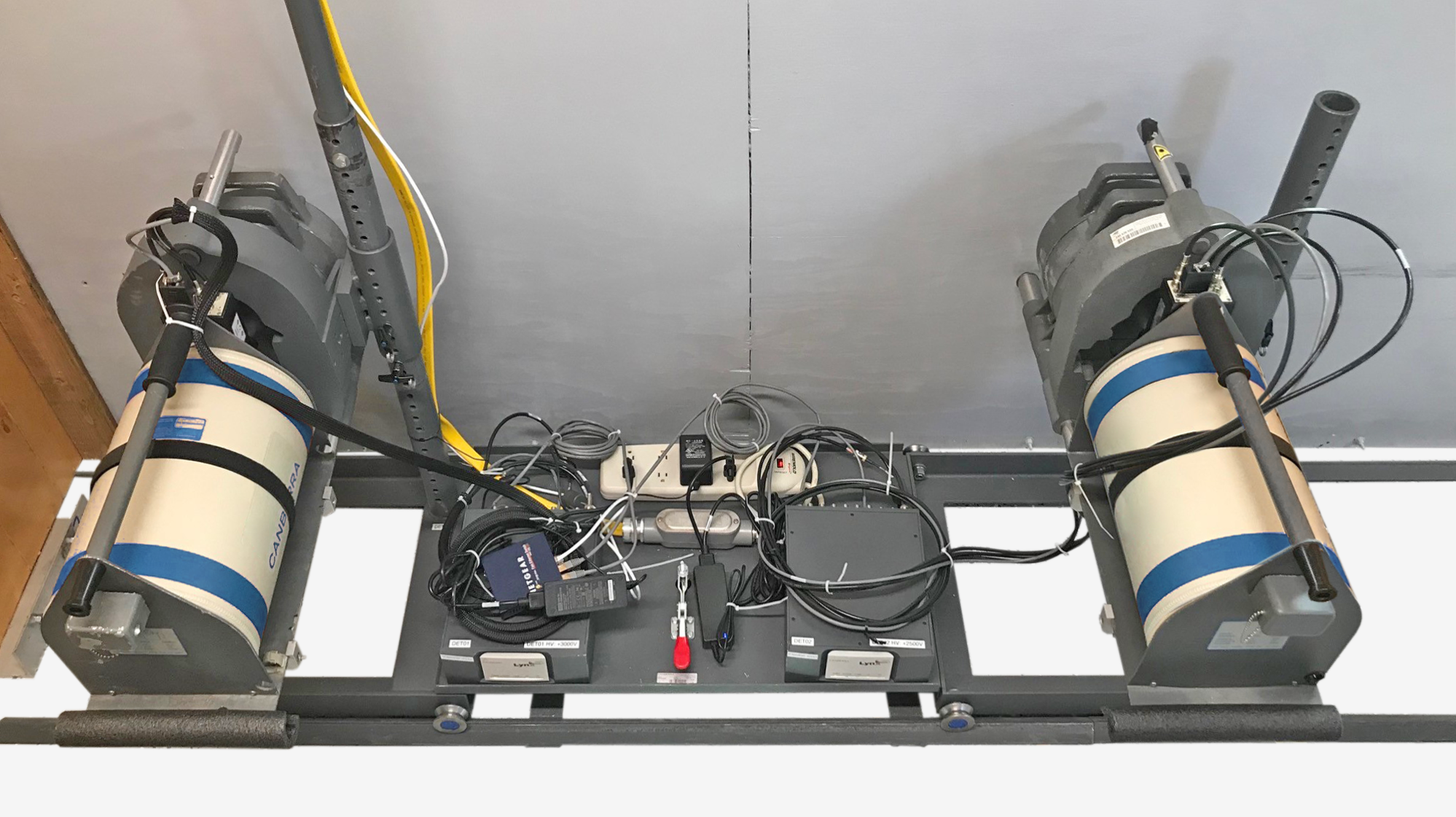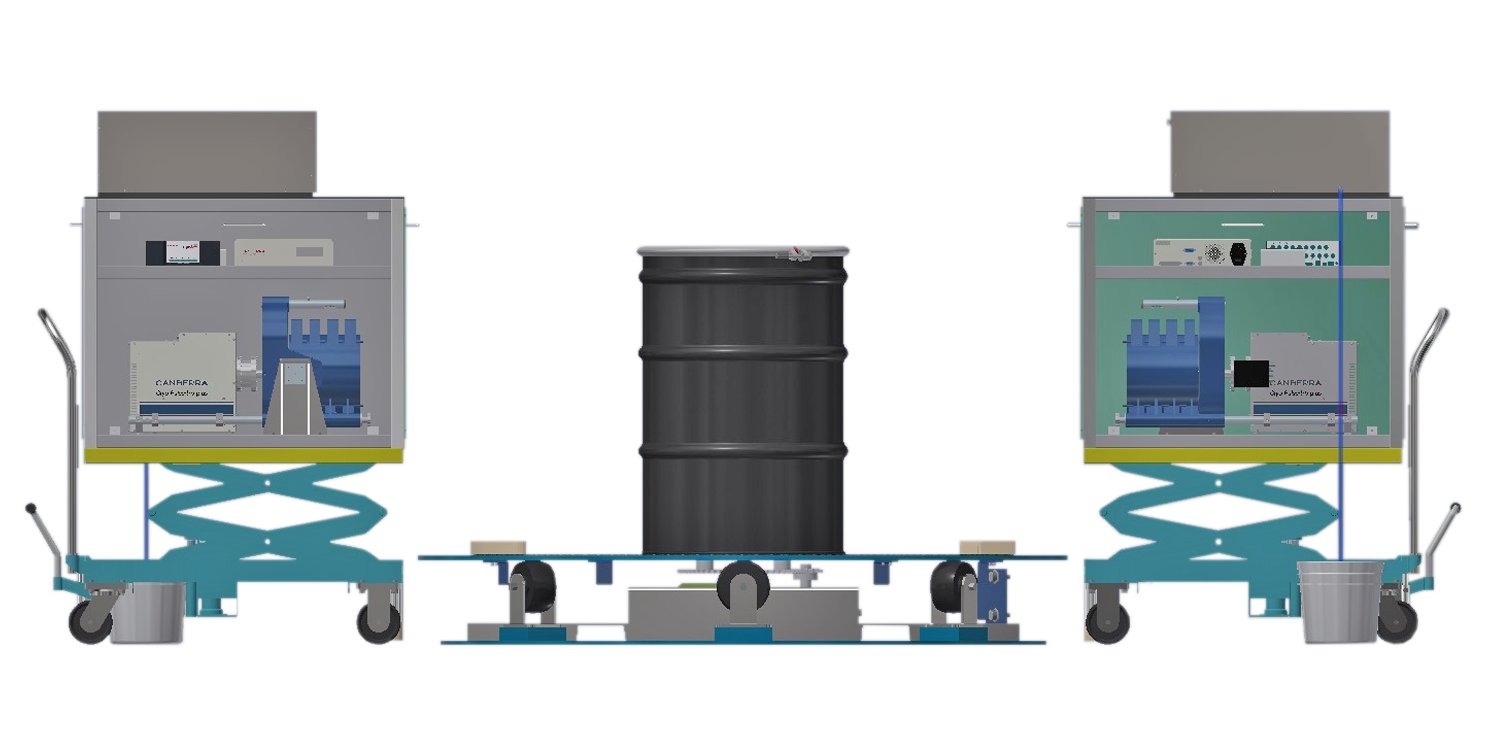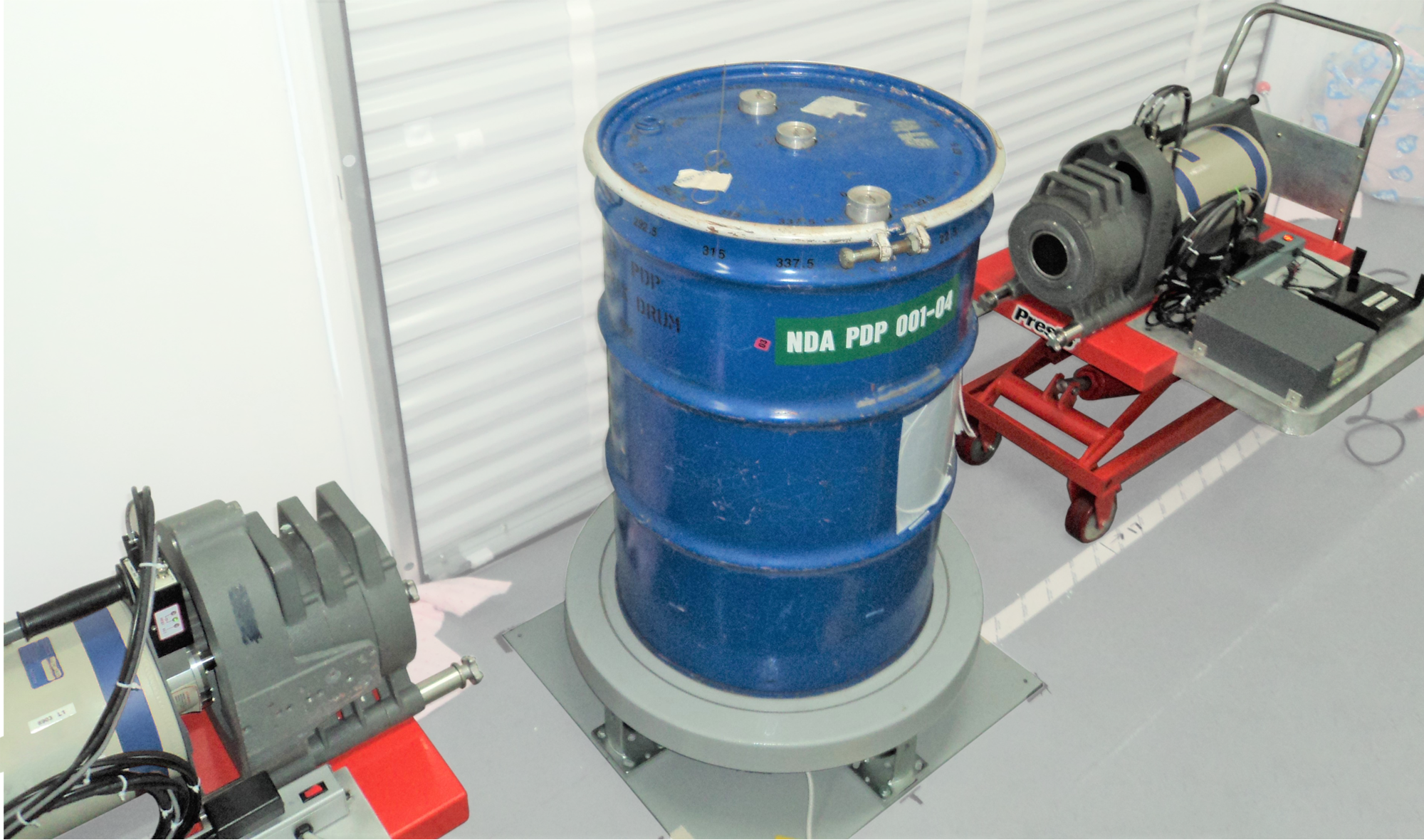MILCC™ System Mobile ISOCS™ Large Container Counter
Flexible and portable system to directly assay radioactive waste containers

Key Features:
- Performs full gamma spectroscopy and accurately characterizes containers of radioactive waste
- Certified by the U.S. Department of Energy (DOE) Carlsbad Field Office for characterization of transuranic (TRU) waste generated at four national laboratories for disposal at the Waste Isolation Pilot Plant (WIPP)
- Flexible design can be configured for items ranging from large containers (e.g. B-25 boxes, Standard Waste Boxes, and Super Sacks) to intermediate (55 gallon, 85 gallon drums) to small (5 gallon buckets, paint cans, 1 L bottles)
- Complex containers, such as the Pipe Overpack Container (POC) used for fissile waste, can be accurately assayed
- Fully assays a B-25 box in 30 minutes and a 55 gallon drum in 15 minutes
- 0.01 Bq/g (0.3 pCi/g) typical detection limit for a B-25 box
- Portable system can be readily mobilized to multiple locations
- Optional turntable for nonuniform drummed waste
- Two germanium detectors featuring:
- Laboratory grade energy resolution for complex analyses
- Low detection limits due to large detector volumes
- Adjustable detector height to match container size
- Adjustable detector-sample standoff to handle high or low activity items
- Cryo-electric or liquid nitrogen cooling
- Real-time assay results
- Network access for remote monitoring and management
- Utilizes a wide range of data analysis tools for accurate results
- LYNX® digital multi-channel analyzers (MCAs) yield clean gamma spectra even at high count rates
Description
The Mobile ISOCS Large Container Counter system reduces the time and labor required to characterize waste by giving you the ability to directly assay shipping containers too large to be handled by traditional waste assay systems. Standard B-25 boxes (typically 4 x 4 x 6 ft) can be assayed to a detection limit of 0.3 pCi/g (typical for nuclides >300 keV and 100% yield) in as little as 30 minutes, and 55 gallon drums can be assayed in 15 minutes or less. Compared to the alternative of unloading the container and counting the contents individually, significant savings in handling time and labor and reductions in risk can be readily achieved. Since a very large fraction of the container is analyzed (much larger than for traditional sampling techniques), a more accurate result is commonly obtained for those samples with non-uniformly distributed radioactivity and/or waste matrix.

MILCC deployed as a drum and box counter in a trailer.
Modular Design For Flexibility
The counter utilizes a modular design, allowing it to be easily adjusted to handle a wide range of container sizes and shapes in optimized configurations.
MILCC Measurement Capability
| Waste Container Types | |
|---|---|
| Drums, cans, and bottles: 1 L to 110 gallon or larger | Boxes: B-25, B-12, Standard Waste Box, Corrugated Metal Box, etc. |
| Drum Overpacks | Super Sack |
| Pipe Overpack Container | Many others |
| Shielded containers | |

Portable System With Moveable Detector Assemblies
Moveable detector carts, adjustable for both sample height and width, are the key to the counter’s flexibility. Position them on either side of a container stand and you have a system configured for the automated assay of boxes or drums. Or, deploy the detectors in parallel next to a loading dock, drive up a truck with a loaded Super Sack, and the same system can be used for assaying large sacks of excavated soils or sludges. The basic system configuration is quite portable, so it is possible to set up the system in a trailer to measure boxes one day, then pack it up and move it to a different location to measure drums the next day
The standard detector carts can be adjusted manually to specific detector heights and detector-container standoff distances. Motorized conveyors and turntables can be supplied to automate the loading of drums, drum rotation during measurement, and unloading of drums.
Germanium detectors are used because they are much less susceptible than sodium iodide detectors to changes in the ambient environment. In addition, the superior energy resolution of germanium detectors is a major benefit in analyzing the complex multi-nuclide gamma spectra often found in radioactive waste streams.
Each detector is housed in a shielded and collimated module to minimize interferences from environmental and operations backgrounds. Different shield thicknesses and collimator angles are available for different measurement scenarios.
ISOCS Sourceless Efficiency Calibrations
Mirion’s ISOCS mathematical efficiency calibration software is used. This eliminates the need to purchase, manage, and handle radioactive sources to perform traditional efficiency calibration measurements. The ISOCS software can model a wide range of waste containers, waste matrices, and container-detector geometries. Each germanium detector is shipped with an ISOCS intrinsic efficiency calibration specific to that detector. The ISOCS efficiency calibration approach has been accepted by the Department of Energy, the Environmental Protection Agency, and many state environmental agencies.

MILCC configured for Super Sack measurements.
NDA 2000™ Non-Destructive Assay Software Controls Data Acquisition and Analyses
Mirion NDA 2000 software is used to perform all assay measurements and includes the following features:
- Full control of data acquisition electronics
- Automated assay system operations, including conveyors and turntables
- Separate assay parameters for different container types and waste streams, including ISOCS efficiency calibrations
- Standard and customized nuclide identification and analysis libraries
- Powerful analysis tools including MGA™, MGAU™, FRAM™ software, SAC, LACE, and multicurve density correction
- Customer editable report formats
- Daily QA checks on system and individual detector performance
- Post-measurement data re-analyses
- Total Measurement Uncertainty (TMU) calculated and reported for each assay
- Full storage of all data, setup parameters, calibration parameters, and assay results
- In compliance with the requirements of ISO 9001 and ASME NQA-1

Side view of 55 gallon drum measurement configuration with large turntable.
Performance
The performance varies with the details of the system configuration (size of detectors, container type, measurement geometry), ambient background, waste matrix and density, nuclide, and counting time. The following description gives an outline of the conditions that can be expected and the results that can be obtained from a typical MILCC system installation.
Assumptions and Typical Conditions
- Detectors properly shielded and collimated
- 0.1 µSv/h (0.01 mR/h) ambient background
- Gamma energies from 100 – 1500 keV
- 100% gamma abundance for the measured nuclides
- 30 minute counting time for a B-25 box
Environmental Conditions
- -40 to 55° C with environmental enclosures, 5 to 35° C without enclosures
- Free from dust or other radioactive contaminants
Typical Sensitivity (MDA) for Two-Detector System
- Low density matrix (0.3 g/cc): 0.01 Bq/g (0.3 pCi/g)
- High density matrix (1.8 g/cc): 0.001 Bq/g (0.03 pCi/g)
Configuration Options
- Cooling: LN2 (liquid nitrogen) or Cryo-Pulse® 5 cryostat (electric)
- 25 mm or 50 mm shielding, 180-degree, 90-degree, 30-degree, or custom collimation
- Detector filters for high count rate situations
- Fully remote operation using wired or wireless modems
- Drum turntable: manual or automated
- Detector cart: fixed or adjustable height
- Multiple container types
- Multiple detector positions
- Environmental detector enclosure for deployment in harsh environments

MILCC deployed at the Transuranic Waste Processing Center in Oak Ridge, TN.